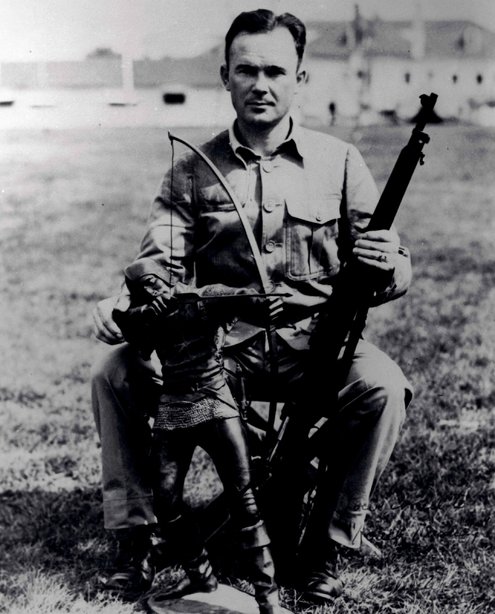Introducing a new feature here on MFL to celebrate some truly amazing men who may not be “famous” in the general sense of that word but who have made a significant impact on the world at the time of their passing. These are men whose exploits, adventures and expertise we can admire and possibly even emulate but never duplicate. In short, they embody the very definition of a life well lived and we salute them and honor their accomplishments. Their like won’t come again and it’s important that we recognize and celebrate their deeds.
From The New York Times, the story of one of the baddest good guys you could ever hope to meet and a marksman nonpareil:
Walter R. Walsh, a world-class marksman who shot clothespins off laundry lines as a boy and went on to become an F.B.I. legend in shootouts with gangsters in the 1930s, an Olympic competitor and a trainer of generations of Marine Corps sharpshooters, died on Tuesday at his home in Arlington, Va. He was 106.
His son Walter confirmed the death.
Mr. Walsh was still winning handgun awards and coaching Olympic marksmen at 90, and aside from some hearing and memory loss, he was fit and continued to live alone at home. At the centennial of the Federal Bureau of Investigation in 2008, he was recognized not only as the oldest living former agent, but also as older than the organization itself by more than a year.
He joined the F.B.I. in 1934, a short, feisty James Cagney tough guy fresh out of Rutgers Law School. A natural left-hander, he was already a dead shot who could cut the center of a bull’s-eye at 75 yards with a rifle and blaze away at moving targets with a pistol in each hand — an enormous advantage in a bureau that was just breaking in its first class of agents authorized to carry guns.
“I thought to myself, This might be a good outfit to tie up with,” Mr. Walsh recalled in an NPR interview in 2008. “I am not trying to pin medals on myself, but the people in the F.B.I. knew that I was very handy with firearms.”
It was the age of gangsters in Depression America, of John Dillinger, Bonnie and Clyde, Baby Face Nelson, Ma Barker and the Brady Gang. There were rub-outs on the streets of Chicago, holdups in countless banks and running-board gun battles. Post offices were plastered with public enemy posters, and newsreels featured the scowling F.B.I. director J. Edgar Hoover.
Mr. Walsh quickly rose to prominence. In his first year, he discovered the body of Baby Face Nelson, who had killed two agents in a shootout in Barrington, Ill., and, although mortally wounded, got away. The F.B.I. mounted a multistate manhunt, and Mr. Walsh found him in a ditch in what is now Skokie, Ill., then known as Niles Center.
Two months later, on Jan. 8, 1935, he captured Arthur (Doc) Barker, Ma’s son, who was wanted for bank robberies, three murders, two kidnappings and a jailbreak. Mr. Walsh picked up his trail in Chicago and confronted him near his hide-out. There was a chase, but Barker slipped on an icy sidewalk and fell. Mr. Walsh ran up and stuck his .45 behind Barker’s ear. “Don’t move, Doc, or I’ll kill you,” Mr. Walsh later recalled saying.
“I asked him, ‘Where’s your heater, Doc?’ ” Mr. Walsh said. “He said, ‘It’s up in the apartment,’ and, ‘Ain’t that a hell of a place for it?’ I said: ‘No. You’re lucky, Doc.’ ”
Read more about of Walter R. Walsh’s amazing life here.


